INTRODUCTION
From the past several centuries, warships have been armed with a large number of guns for fighting other ships. This continued until the 1950s, when the anti-ship cruise missile entered service on board warships of the Soviet Union. The anti-ship missile (AShM) was a fast, accurate and lethal weapon which had an incredible number of advantages over the large, slow firing and inaccurate naval guns of that time. Other major navies quickly adopted this technology and developed their own missiles or imported them. The heavy-caliber guns started disappearing and were progressively replaced by missiles.
This led many analysts, strategists, navies and designers to consider the naval gun as an obsolete piece of weaponry which was unnecessary on a modern warship. Many ships during the 1970’s were built with a missile-only armament. However they had to find out the hard way that guns can never be entirely replaced by missiles and that both these systems complemented each other if used in the right manner. This article analyzes the various modern guns in service today, their capabilities, advantages and the technological innovations which have made guns popular again.
GUN CUPOLA DESIGN
Stealthy cupolas have defined how modern naval guns look. A cupola is the covering on top of a gun which protects the working elements from weather and water. It was determined that a traditional looking gun cupola with it’s rounded figure, ladders and other attachments reflected a lot of radar waves and increased the radar-cross section (RCS) of the ship. In order to reduce the RCS, the cupola designs were given a multi-faceted design to deflect radar waves. It also has the side benefit of making the gun look better by giving it



If you look at the pic of the gun with the stealthy cupola, you can notice that the barrel is exposed. This cylindrical barrel is also a reflector of radar waves and can contribute to the RCS of a ship. Hence some very-stealthy warships use a design where the barrel of the gun is nested in a stealthy casing in front of it. This allows for a small but meaningful reduction in RCS and the drawback is additional costs. The 57 mm Bofors, 76 mm Oto and 155 mm AGS have been fitted with such stealth barrel coverings on ships of the Swedish, UAE and the US Navy respectively. The barrel rests in the casing when the gun is not in use and can be withdrawn by elevating the barrel and sliding open the covering.



EVOLUTION OF NAVAL GUNS ( 1940s – present)
Let us now have a look at a few of the naval guns of WW2 and their modern day equivalents. These pictures will give you an idea about the modernization that has occurred over the decades. As explained earlier, the design of the gun cupolas has also evolved greatly. Further analysis in the article will deal with these modern guns.








ROLE OF MODERN NAVAL GUNS
As stated, guns complement the missiles and offer a unique set of capabilities. This has standardized the use of naval guns in several roles such as
- Anti-piracy : Guns of various calibers are typically used to engage pirate vessels. It would make little sense to use an expensive missile to blow up a boat. In many real life situations, 30 mm and 127 mm guns have been used to blow up pirate ships.
- Warning shots : In several situations, warning shots are fired by a naval guns to convey a strong message. This is not possible with missiles.
- Shore bombardment : During amphibious landings, naval gunfire support is provided and it involves firing thousands of shells in support of the landing troops. It basically acts as a naval howitzer in this role.
- Surface Warfare : This would involve the use of a gun to destroy another ship in a combat scenario. Typically a warship would engage an unarmed merchant vessel/oil tanker. Direct engagement between warships using guns would be a last resort if no missiles are available.
- Anti-air warfare : Guns are surprisingly effective against incoming aircraft and missiles. Special types of guided ammunition with proximity fuzes and fragmentation shells are used to engage flying objects. Smaller caliber guns with high rates of fire are also extremely popular for this purpose although medium caliber guns are gaining popularity.
- Littoral warfare : Small and medium caliber guns with high rates of fire are popular in the littoral environment to engage fast-moving small-craft. Guns with guided shells are extremely effective in this role.
ADVANTAGES OF GUNS OVER MISSILES
As missile technology progressed and AShMs were made faster and deadlier, they became incredibly expensive as well. This called for a low-high end weapons combination of guns and missiles to tackle a variety of threats. Modern guns have far higher rates of fire when compared to their WW2 counterparts. The development of a variety of radar, optronic and IR sensors to guide gunfire has significantly improved their effectiveness and accuracy. The latest advancement in small-caliber guns is the incorporation of a remote-controlled turret which enables the operator to fire the gun accurately from the safety of the ship’s interiors. Most of these RWS (Remote Weapons Stations) have gyro-stabilized turrets which allows them to hit targets with ease even in rough seas. Also RWS are fitted with a variety of sensors to increase their accuracy further. Larger caliber guns have seen an advent of long-range guided shells which enable them to hit targets with precision at 50-100 km ranges. Such a thing was unimaginable earlier as the largest guns in existence had a maximum range of around 40 km with moderate accuracy. These features and advancements have made guns extremely relevant today. The advantages offered by modern naval guns over anti-ship cruise missiles are
- Cost effectiveness : An anti-ship missile is around 2000 times more expensive when compared to a large-caliber unguided gun shell. This matters a lot as most of the targets don’t require the use of a missile unless you are fighting a major war. Especially when engaging soft targets like small boats, guns are very economical.



- Large number of rounds available : A destroyer typically carries 300-500 shells for it’s main gun and thousands of rounds of ammunition for it’s smaller guns. Whereas only 8-16 cruise missiles are usually carried in comparison. These missiles are very useful against high value targets which are very far away. But low-value targets which are closer can be engaged by medium/large caliber guns.

- Shells cannot be shot down by missiles : The biggest advantage that large caliber gun shells ( 76, 100, 127 mm) have is that they cannot be shot down by the defense systems of the enemy vessel. A barrage of guided 127 mm shells could cripple a sophisticated destroyer equipped with the most advanced radars and surface to air missiles. A CIWS like Phalanx can actually shoot these shells down using a barrage of 20 mm bullets, but it would run out of ammunition after downing a few incoming shells. So there is no guaranteed defense against them. In the future, 155 mm Railgun shells of the US Navy’s Zumwalt class destroyers will be completely immune to any defense systems due to their high speed of Mach 5-6.

- Electronic jamming and decoys are useless : Even modern and sophisticated cruise missiles can be misled by electronic jamming, flares, chaff and other decoys launched by the target. Unguided shells can hit a target even in the densest electronic warfare environment as there is nothing on them which can be jammed.

- Ability to engage targets extremely close to the ship : Cruise missiles have a minimum engagement range of 5-10 km from the launch platform. This is because they need to stabilize after launch, reach a minimum safe distance from the launch platform, lock onto the enemy ship and then hit the target. But a gun shell can be safely fired at a target which is as close as 10 meters.
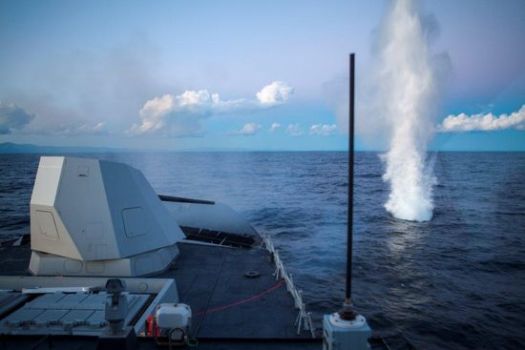
TYPES OF NAVAL GUNS
Every gun from the smallest caliber to the largest, from the most rudimentary to the most advanced plays an important role on board a warship. We will examine the most popular gun calibers in ascending order and have a look at the advantages they offer.
7.62 / 12.7 / 14.5 mm
These machine guns come under the category of ‘small arms’ and are not referred to as naval guns. But they are still being included in this article as these guns are an indispensable part of every warship from the past hundred years. Corvettes, frigates, destroyers and even aircraft carriers have multiple mounts for machine guns of various calibers. The 3 mentioned calibers are preferred as they offer maximum stopping power at ranges of 1-2 km. These guns are used to tackle threats like enemy boats, combat swimmers, pirates, terror attacks and are very often used for firing warning shots at the enemy. A major warship usually has 5-10 mounts for machine guns and smaller ships have 2-4 mounts.


Many improvements like advanced optical sights, remote weapons stations and stabilized platforms have increased the accuracy and lethality of these machine guns. A typical 7.62 mm machine gun fires at 600-900 rpm and a 12.7 mm gun fires at 300-400 rpm. For situations when higher rates of fire are preferred, some navies have fitted Gatling guns on their warships. The Royal Navy is a major use of such guns called as ‘Miniguns’, the Mk 44 in particular. This gun has 6 rotating barrels and enables rates of fire of around 3000 rpm!


12.7 mm machine guns are extremely popular as well. Trading rate of fire for significantly greater range and stopping power they are usually the first weapons used to engage low-intensity maritime threats. Almost all the navies in the world deploy this caliber machine gun on their warships. The popular guns in this caliber are the American M2 Browning and the Russian NSV. There are a few prototype 12.7 mm gatling guns as well, but they aren’t in service. The US Navy uses a combination of 2 x M2 Brownings on a single mount on several of their warships in order to get a higher combined rate of fire.

Russia however prefers the 14.5 mm Machine gun to the 12.7 mm on some ships. This gun offers many advantages like a longer range (effective for more than 3 km against targets like boats) and more stopping power over the 12.7 mm machine gun. They are at present the only major user of the naval 14.5 mm machine gun.
20 / 25 / 27 / 30 mm
Guns of these calibers were largely neglected from the 1970’s as the threat perception emphasized larger guns and cruise missiles to engage targets. But the Falklands War and the attack on the USS Cole provided a major reason to install such guns on major ships, which resulted in the standardization of these guns on every American and European warship. The main advantage of these guns was their ability to engage low flying aircraft, fast moving boats and helicopters at distances of 3-5 km from the ship with great effectiveness.

The 20 mm gun is the least used among the three. Oerlikon 20 mm guns were extremely popular as anti-aircraft guns during the 1940s-50s, but they have been progressively replaced by higher caliber guns in their role. The French have started using the 20 mm gun on their newer warships when other navies are preferring the 25/30 mm guns. This could be because the 20 mm is extremely compact, lightweight and offers a higher rate of fire when compared to the 25/30 mm guns. Israel is another user of the 20 mm gun, which is now mounted on Typhoon RWS for their fast attack boats.


This caliber however is very popular in the Gatling gun category where it is used primarily against aerial threats. The 20 mm Phalanx uses a 6 barrel Gatling gun which fires 20 mm projectiles at the rate of 4500 rpm to an effective range of 3.5 km. It is undoubtedly the most widely used western CIWS (Close in Weapons System), noted for it’s ease of installation (needs no deck penetration), high ammunition capacity (1550 rounds) an dintegrated radar and EO/IR sensors which allowed autonomous operations.


The US Navy is a major user of the 25 mm caliber on their destroyers and frigates (retired) but they prefer the 30 mm mounting for their LCS and LPDs. Each Arleigh Burke class destroyer is equipped with 2 x 25 mm Mk 38 Bushmaster cannons . They can be fired manually or remotely depending on the situation. The US Navy is the only major user of 25 mm guns at present.
The 27 mm gun is another rare caliber which has limited usage around the world. The German Navy is a major user of this type and the Mauser MLG27 RWS, which uses the BK27 revolver gun, is installed on their latest surface combatants. It has an extremely high rate of fire of 1700 rpm, which is unique for a naval gun of such a caliber. This high ROF enables it to be extremely effective against high speed aerial targets as well. Having a maximum effective range of 4 km, it is pretty much on par with the 30 mm guns.
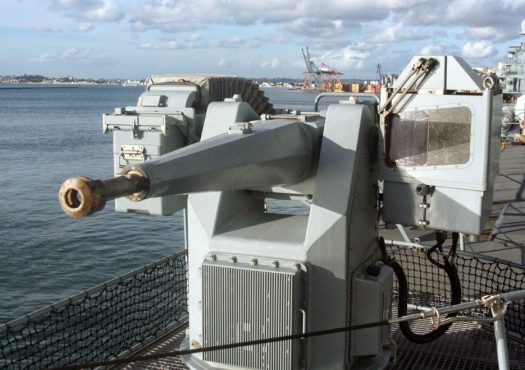


The 30 mm is the most widely used caliber. This is because the 30 mm round offers longer range and more stopping power when compared to the other two. The most popular 30 mm gun mounts are the single barrel Oerlikon, Mk44 Bushmaster, CRN-91. The multi-barrel Gatling mounts include the Ak-630 and Goalkeeper. The single barrel mounts are primarily meant for surface targets as they have low rates of fire and no radar guidance, whereas the Gatling guns are for anti-aircraft/missile roles and are radar guided.
35 / 40 / 57 mm
These 3 calibers some in the ‘rare’ category and are used on very few modern warships as the popular combination of guns is below 30 mm and above 76 mm.
The most advanced 35 mm gun in service is the Swiss Millennium Gun. This gun is designed as a compact, easy to install and extremely accurate. 250 rpunds are carried on board the mount itself and can be fired at a rate of 1000 rpm. It fires the AHEAD ammunition which is programmed via a magnetic muzzle programmer, thus allowing the rounds to explode in a pre-determined pattern and at an ideal distance from the target. Although it exhibits superior performance when compared to its 20 and 30 mm counterparts, it is fitted on only a handful of ships.

The 40 mm gun was extremely popular during WW2, but it’s usage steadily decreased and there are very few ships of the 21st century equipped with 40 mm guns. Bofors has been and will be the leader in this caliber. The new Bofors features a stealthy cupola and an integrated camera under the barrel for aiming. This caliber has limited usage at present and is unlikely to reach it’s pre-missile era popularity again. Most navies favour 30, 57 and 76 mm guns to the 40 mm nowadays.

The 57 mm gun saw a steady but small usage throughout the second half of the 21st century, with Russia as a major user with it’s twin barreled 57 mm naval gun. However the US Navy has wholly embraced this caliber for its Navy’s Littoral Combat Ships and Coast Guard’s patrol ships. The USN finds this caliber to be extremely effective against fast moving surface targets and low flying aerial targets with the air-burst round preferred for engagement. The Swedish and Finnish navies also prefer this caliber on their corvettes and fast attack boats.

76 mm
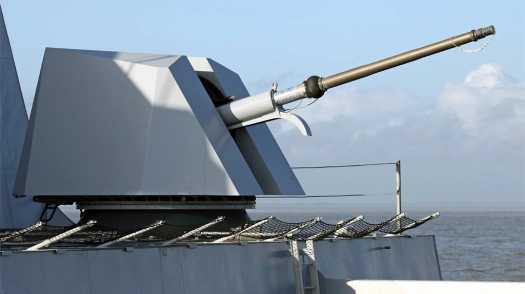
This is the most popular medium caliber gun in the world due to the excellent balance of range, firepower and rate of fire offered by most 76 mm guns. The Italian Oto Melara rules this category and has almost no competition. There are several other guns like the Russian Ak-176, Chinese Ak-176 (reverse engineered) which are also used. The best part about the 76 mm Oto is that it can be installed on small corvettes with ease, providing them with a significant amount of firepower. The high rate of fire of 120 rds/min and the range of 15 km provided by the Oto Melara SRGM makes it the perfect dual-role weapon which can engage surface and aerial targets with equal effectiveness.

The more modern variant of the 76 mm Oto is the STRALES version with an integrated fire-control illuminating radar and advanced DART guided ammunition which rides on the radar beam. This allows the gun to engage a fast moving target using only a few shells, which will hit the target with precision. Guided shells allow the target to be successfully engaged with fewer rounds of ammunition. For example, engaging a low flying missile with unguided 76 mm shells would need around 15-20 rounds to be fired at the target whereas only 4-5 guided shells would be needed to do the same job. The main disadvantage is that guided shells are usually significantly more expensive than unguided ones. Hence a mixture of guided and unguided shells are usually preferred, with guided shells used against high-threat targets and unguided shells used against low-threat ones.
100 / 114/ 127 / 130 mm
This is the beginning of the large caliber naval guns. They are characterized by heavier shells, longer range and slower rates of fire compared to the calibers examined till now.
The 100 mm naval gun is quite popular and its largest user is the Russian Navy, which has them fitted on most of their destroyers, frigates and corvettes. Earlier a major user of 76 mm guns, Russia has completely switched over to the 100 mm A-190-01 gun for the advantages in firepower and range that it offers over smaller calibers. This gun features a stealthy cupola and can fire at a rate of 80 rds/min up to a distance of over 20 km. Being lightweight, it can be installed on any ship greater than 500 tons in displacement. Countries like France, China and India use this caliber gun in very small quantities. Overall the 100 mm gun has a future only with the Russian Navy as the others prefer either the 76 mm or 127 mm guns.

The Royal Navy is the only major user of the 114 mm (4.5 inch) naval gun and it is fitted on each of their frigates and destroyers at present. This caliber has been standard for the Royal Navy since 1938 on all their frigates, destroyers and cruisers. The latest version of this gun is the Mk 8 Mod 1 with the stealthy cupola to reduce RCS, which equips all Type-23 frigates and Type-45 destroyers of the Royal Navy. This gun offers a rate of fire of 25 rds/min and can fire shells to a maximum distance of 27 km ( extended-range shells). It is effective against surface, shore and aerial targets and has seen extensive combat usage. During the Falklands War, the Royal Navy’s Type-42 destroyers and Type-21 frigates fired thousands of high explosive 114 mm shells at Argentine land targets to support the landings.

The 127 mm (5”) gun is the standard large-caliber naval gun of most western navies. It is usually designated as a dual-purpose gun capable of handling surface and aerial threats, but it’s ability to handle fast moving flying objects like cruise missiles and fighter jets is pretty limited. It however excels in the surface warfare role and is the most widely used large-caliber naval gun today. The most famous guns in this category are the BAE Mk45 and the Oto Melara 127/54 Compact. Both guns serve in their upgraded versions today. Guns of this caliber have a effective range of 20-25 km against surface targets and 15-18 km against aerial ones.


The game-changer for the 127 mm gun was the introduction of guided and extended-range shells. This increased the effective range of these guns from 30 km to 120 km and allowed them to strike surface ships or land targets with great accuracy from a standoff distance. The Italian Vulcano shell in particular has given the Italian Navy frigates the ability to engage surface targets at long ranges using only guns, thus saving cruise missiles for other targets beyond the gun’s reach.
The 130 mm was a pretty rare caliber which was used on a a few Russian destroyers, but advanced guns of this caliber have seen a sudden increase in usage with the Chinese deploying them on their latest Type-52D destroyers and Russia deploying them on their Admiral Gorshkov class frigates. It is pretty much their equivalent of the 127 mm as these two guns have nearly similar calibers. Western navies don’t prefer this caliber and they stick with the standard 127 mm (5-inch). The Soviet-era Ak-130 remains the most powerful 130 mm gun with its twin barrels, rate of fire of 60+ rds/min and an autoloader. The Sovremnny class destroyers which were fitted with these guns were reported to carry as much as 2000 rounds in total for the 2 mounts.
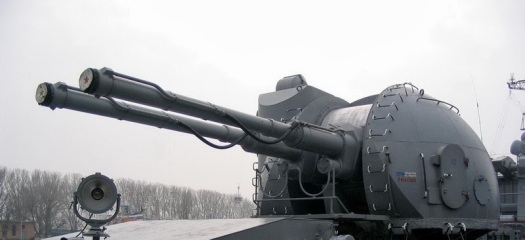
155 mm
This caliber is considered as the ‘Holy Grail’ for naval gunfire support as it offers the perfect balance of range and effectiveness for attacking land targets at long ranges. They were popular on the large cruisers and battleships in the first half of the 20th century and their usage abruptly came to an end. Unfortunately there is no 155 mm naval gun in active service as there are alternatives like 127 mm guns which do a similar job and their rate of fire is considered to be too slow to serve in any other role other than shore bombardment. Comparatively the 127/130 mm guns are dual-purpose and can engage aerial and land targets as well. The development of extended-range shells for these calibers ensured that the 155 mm was not a necessity.

Germany actually tested a 155 mm gun on a Saschen class frigate as a part of MONARC program, but the idea was abandoned due to many complications that arose. The Royal Navy had also shown interest in this caliber and BAE had proposed a 155 mm gun in the present 114 mm gun cupola, but the project was canceled due to budget cuts. However, this caliber will gain a fresh lease of life as the US Navy’s Zumwalt class destroyers are equipped with the 155 mm Advanced Gun Systems (AGS) to serve in the land attack role. They will be equipped with extended-range guided shells which can strike land targets over 100 km away with great accuracy. If shells with radar-seekers are used, then the 155 mm AGS could strike moving ships at distances of 100-150 km and save the longer range anti-ship missiles for other targets.


This caliber has enormous potential for improvement and in the future we may see many navies adopting this gun for surface warfare and naval gunfire support. It is the only caliber which can replace cruise missiles to an extent.
Types of Ammunition
It is extremely important to know the types of modern ammunition which are available to the naval guns discusses above. A wide variety of rounds are avaiable for every gun which allow it to perform different tasks ranging from anti-air warfare, illumination, smoke screen laying and anti-surface warfare. The types of ammunition available are
-
High Explosive (HE)
This is the most common shell for naval guns. It basically cosists of an explosive material inside, which is triggered by a proximity fuse or on impact. It is preferred for shore bombardment and attacking surface targets.
-
Armour Piercing (AP)

Traditional AP rounds are not very popular for large naval guns. However AP-Incendiary rounds are quite popular as they help the round to pierce the hull of the ship and set fire to whatever is inside. Pure AP rounds are used in 20 and 30 mm CIWS mounts to penetrate the metal coverings of the incoming missile. For example, the Phalanx CIWS uses depleted uranium penetrator rounds for it’s 20 mm Gatling gun.
-
Incendiary
These are the type of shells which contain flammable material inside them. They are used to set targets like oil tankers or other soft targets on fire.
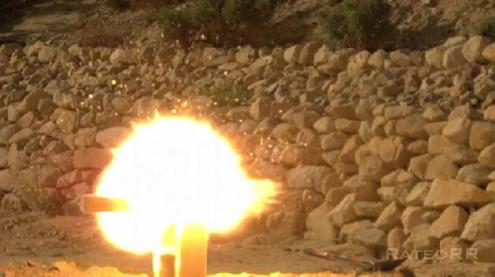
-
AHEAD
This is a fancy airburst round for the 35 mm Millenium gun. This particular round contains 152 high density tungsten balls to form shrapnel when the shell explodes near the target. It is more accurate than traditional airburst shells of other calibers as each round is programmed magnetically while exiting the barrel
-
Airburst
This is an extremely popular round as it’s usage is on-par or higher than the HE ones. Airburst shells are those which explode near the target and shower them small shrapnel, usually pre-fragmented metal balls or pieces. This is extremely effective while engaging aerial threats like missiles and aircraft. A salvo of airburst shells spray the fast moving target with shrapnel, thus causing extensive damage to their control surfaces and body, causing the target to crash into the sea. Airbust ammunition is available for all calibers 35 mm and above.

-
Guided
Large caliber ammunition guided by satellites, radar and IR sensors have become popular as they offer the accuracy of a cruise missile at a fraction of the cost.

-
Rocket Boosted Ammunition
Rocket boosted shells have a small rocket motor which powers a shell partially through it’s trajectory. Such a mechanism can double the range of the shell. They are used in some 127 and 155 mm shells which are intended for long-range land attack applications.
The Rail Gun


Commonly heard of only in fiction movies, novels and videogames, the Railgun is at present no longer fiction. Developed for the sole usage of the US Navy, the Electromagnetic Railgun is all set to change the way naval surface warfare and land attack works. Firing non-explosive projectiles at a speed of over Mach 7 (7 times the speed of sound) to distances greater than 200 km, the Railgun depends on kinetic energy to destroy its target. The best part about this is that such a shell cannot be intercepted by any defense systems in the near future, thus allowing the USN to strike targets with impunity. The US Navy intends to use this gun for naval gunfire support and develop a variant in the future which would be capable of shooting down incoming cruise missiles and ballistic missiles. The prototypes are being tested at present and the US Navy plans to fit one of these guns on the Zumwalt class destroyers in the next decade.

CONCLUSION
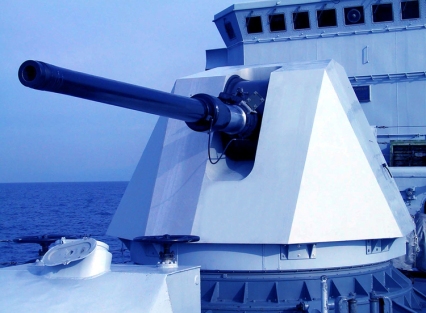
We have examined all the existing calibers of naval guns, their performance and their operators and come to the final conclusion that guns are indispensable on a warship. In the future as missiles get more advanced and powerful, guns and ammunition are becoming smarter and deadlier as well. They are no longer a customary installation on a warship, but an absolute necessity. In the 2nd half of the 20th century, missiles started replacing guns in various roles, but now we see that guns have started replacing missiles to a large extent in many roles. It is safe to say that in the future, naval guns and missiles will co-exist and depend on each other to cover their weaknesses.
If you enjoyed reading the article, do rate it below.
You might also like
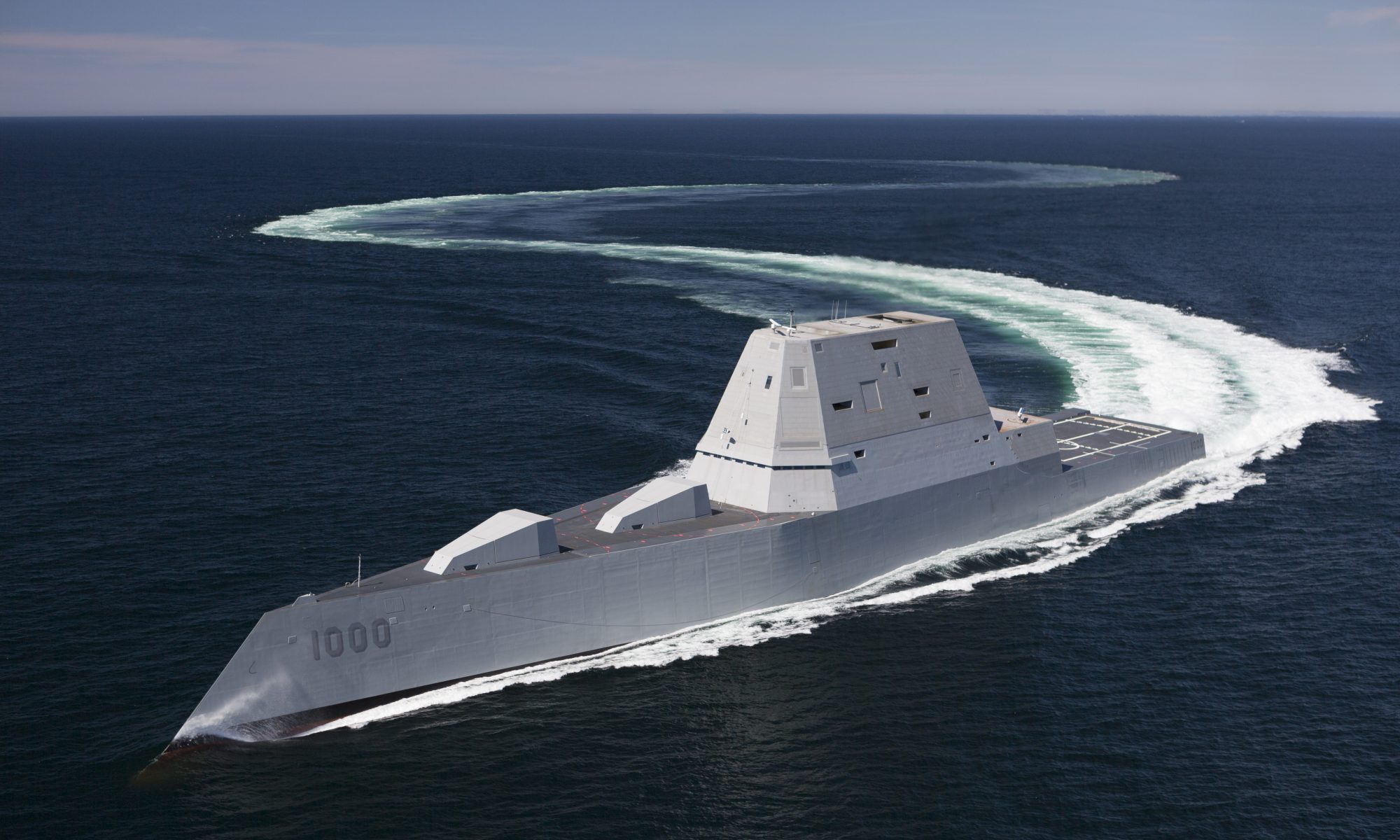





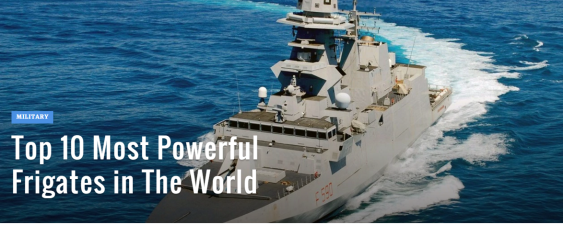
Very Informative, It was worth the wait. Though I do look up the site every day for updates.
It would be grand if the frequency of the articles improved. But as long as your are giving quality stuff like this, take your time.
p.s. could you write about the Indian Navy’s submarine arm and its future?
LikeLiked by 1 person
Thank you. Will keep your suggestion in mind 🙂
LikeLike
A good reminder that naval guns are still quite useful…
LikeLike
What about destroyers that carry only one 127mm gun? (e.g. INS Visakhapatnam )How will they engage aerial targets? With AK 630 alone??
If you remember I requested an article about different types of SAMs. Is that still in pipeline or you have abandoned the idea?
LikeLike
There is no modern destroyer that carries more than 1 x 127 mm gun. They engage aerial targets with that single gun itself.
Article about SAMs will be done in the near future.
LikeLiked by 1 person
Yeah but 127mm guns have a slower rate of fire than 76mm guns.
Then why go for big guns with costly shells?
Thanks for looking into SAMs
LikeLike
Bigger shells and longer range make up for slower rate of fire. These guns are excellent in surface warfare ad well. That’s why many navies prefer these guns for larger ships.
LikeLike
What caliber do you think will be commonly used in future? High caliber, like 130 or 155, or medium – 76-100?
LikeLike
76 mm and 127/130 mm will be extremely popular. 155 mm will be used sparingly.
LikeLike
very good article, lot of information. Can you do article on top howitzer and artillery guns
LikeLike
Thanks. Will keep your suggestion in mind.
LikeLike
Very informative and well written. Congrats.
LikeLike
Thank you
LikeLike
Very informative article, can’t ask any question about guns.
I requested about an article on marine propulsion, it would be a great article.
Can you right an article on top conventional submarines around the world?
LikeLiked by 1 person
Marine propulsion is a good idea. Will try to make an article on it.
LikeLike
Another operator of 25mm guns is the Philippine Navy with a bunch of mk 38’s, also I fail to understand why the Royal Navy needs miniguns for on their ships
LikeLike
It’s extremely weird. They don’t use 12.7 mm guns on their ships. The Minigun is just a waste of money and ammunition for it’s roles. Maybe they want to use it as a last ditch anti aircraft weapon. Fears left over from the Falklands war I guess.
LikeLike
I doubt 7.62mm would work as an anti-air weapon
LikeLike
Admin , can u provide an detail article on Mountain warfare ?
LikeLike
Nice article, like all the others.
Will you write an article or just give brief information, for the time being, on:
Zumawat (Is the spelling correct?) class destroyers of US Navy.
USS Gerald Ford (or whatever it is called) Aircraft carrier of US navy.
Also what is the range of Rail Gun?
BTW what will be the next article based on?
Thanks and keep up the good work 🙂
LikeLiked by 1 person
Thank you. I will try to write something about Zumwalt class and Ford class.
The range of rail gun is over 200 km.
My next article will be mostly on AIP
LikeLike
Just discovered this site. Wow! Good stuff.
I read that some land-based artillery have a neat trick of firing salvoes timed for simultaneously impact on the target by firing one shell, changing elevation and firing another (at a different energy level somehow I assume) and then so on for however many simultaneous rounds are supported/desired. Can any of the naval guns do this, e.g. Otto Merla 76mm or BAE 127mm?
LikeLiked by 1 person
Thank you. What you are referring to is called MRSI ( Multiple round simultaneous impact). It can be done by all modern land based artillery which are computer controlled.
Naval guns also can theoretically do this and it had been shown by Oto Melara in an advertisement video for the 76 mm gun, where they attack land targets using MRSI. Even the 127 mm gun can do it. All they need is the corresponding software upgrade to do so. It is actually easier for naval guns to do MRSI as they have significantly higher rates of fire when compared to their land based artillery counterparts.
LikeLike
I think land based artillery need MRSI… Given their far shower rate of fire… But naval guns… With their greater rate of fire achieve similar results without having to resort to MRSI.
LikeLike
Does that means that land based artillery needs to be like the naval artillery. Take for example the 127 MM on Vishakhapatnam class destroyer. If the same millimeter gun is transformed into a land based artillery mounted on a truck with it’s ammunition replenishment close by and constantly upkeeping it. How feasible is that?
LikeLike
Naval artillery have more complex loading systems which would be impractical to implement on land based artillery. Also naval guns like 127 mm and 76 mm have constant flowing water cooling their barrels. The water spills out in front with every shot. It would be impractical to implement such a cooling system on land based guns. To do so, land based guns would need to be fixed to the ground with their large and complex reloading and cooling systems plus ammunition magazine.
LikeLike
Defencyclopedia, how about an article about amphibious warfare?
LikeLike
Will keep your suggestion in mind
LikeLike
Are you the sole contributer of articles to this website? Would you like any assistance in writing articles? If you like I could submit something to you to see if it meets your standards.
LikeLike
Hi Stuart
I am extremely sorry for the late reply. Your comment was flagged as spam for some unknown reason and I came across it while clearing the spam tray. I have approved it now.
You can definitely submit any article of yours. I will consider publishing it as long as it meets the standards. My apologies for the late reply once again. Looking forward to hearing back from you.
LikeLike
I would think Royal Navy uses the mini guns as throwing up wall of metal principle. That high a rate of fire could be useful when getting bombs thrown at you by Skyhawks at under 100 feet (35 metres). My feeling is it’s probably the high rate of fire that is the attraction and let’s look back at the timescale of there introduction. They were probably viewed as useful when used in combination with other sized caliber guns on the ship.
LikeLiked by 1 person
I don’t know honestly, 7.62mm doesn’t have enough stopping power as an AA gun unless you’re shooting at a very thin-skinned target, on the other hand, that RPM is wasteful against a pirate boat
LikeLike
Nice article… Keep up the good work…
But when are you writing an article about marine propulsion..
It would be a nice article
LikeLike
Railguns are going to be a huge game changer for Navies around the globe.
LikeLiked by 1 person
A cruiser armed with four 155 mm guns in two low radar signiture turrets, in addition to batteries of 30 mm machine cannon and various guided missiles, would be a fearsome opponent and would be a very cost effective weapon, especially if low cost ammunition for the 155 mm guns could be developed.
LikeLiked by 1 person
This site is extraordinary. The research needed to write such articles is mind boggling. Kudos.
LikeLiked by 1 person
Thank you 🙂
LikeLike
fantastic write up
LikeLike
Thanks for the excellent overview of modern naval guns!
LikeLike
Outstanding article, You do ur homework with diligence. Try to include an article about types of explosives (means their chemical nature and energy output per unit etc)….Do include working of MOAB in it 🙂
LikeLike
Thanks a lot for an informative article. Do you have any study regarding standard naval guns for frigate, Corvette, LPC and other smaller ship? I need to know what are the standard guns for various classes of ships.
LikeLike
Informative article. Keep on.
Sir, What is the difference between Shells fired by Tanks(125 mm) and by Na
LikeLike
What is the diff. btween 125mm tank Shells and 127/130 naval gun shells?
LikeLike
Naval gun shells are large artillery shells. Tank shells are not artillery shells. They are designed for flat trajectories
LikeLike
Hi NRP,
What a difference 2 years makes.
The vaunted 155mm shell for the Zumwalt is cancelled.
Australia has chosen it’s new Lurrsen OPV and will arm the 12 of them with 40mm guns, the calibre the article said wasn’t very popular now. South Korea’s new amphibious assault craft will be armed with the 40mm as well.
https://www.naval-technology.com/projects/cheonwangbong-class-landing-ship-tank-lst/
I have wondered about the Vulcano shells- surely a 120km range would entice every navy to change to Oto Melara 5 inch guns. Does the shell really have a proven range? Is it accurate? Why don’t navies change from the BAE version with a 24-35km range?
LikeLike
Finland is updating their Hamina class missile boats IAI Gabriel V missiles that have a range of 200-400 km. They are also replacing their 57mm guns with 40mm guns to save weight because they are mounting 2 triple ASW torpedoes to deal with submarine threats.
LikeLike
What would happen if two ships have the same gun (e.g. the OTO Melara 76mm) and one fires at the other with a VULCANO round? Would the other ship be able to shoot down that VULCANO round with a VULCANO round of its own?
LikeLike
76 mm Vulcano shell is not designed for counter shell engagement.
LikeLike